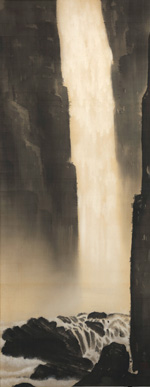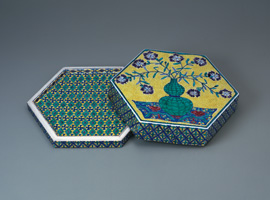Collection GalleryThe 2nd Collection Gallery Exhibition 2017–2018 (130 works in all)
Collection Gallery
HOME > Collection Gallery > The 2nd Collection Gallery Exhibition 2017–2018
The 2nd Collection Gallery Exhibition 2017–2018 (130 works in all)
Exhibition Period
6. 14 (Wed.) – 8. 6 (Sun.), 2017
Overview
In the second Collection Gallery Exhibition of this fiscal year, we present works dealing with a wide range of themes, including displays related to Mastery of an Art: Van Cleef & Arpels – High Jewelry and Japanese Crafts (currently underway in the Special Exhibition Gallery on the third floor), and the latest offering in our Curatorial Studies series, commemorating the 100th anniversary of Marcel Duchamp's readymade work Fountain.
Beside the entrance to the Collection Gallery is a corner devoted to the posters of Adolphe Mouron Cassandre. The artist enjoyed great popularity as an advertising designer at the time of the 1925 International Exposition of Decorative Arts and Modern Industries (or Art Deco exhibition), which was also the event that brought Van Cleef & Arpels (founded in 1906) widespread attention. Cassandre exerted a strong influence on graphic designers of the era, including many Japanese artists. In another special exhibit, we examine trends in modern French painting from the middle 19th to the early 20th century by tracing the evolution of key movements such as Impressionism, Post-Impressionism, Les Nabis, Fauvism, and Ecole de Paris. We hope that you will enjoy savoring the flavor of French art and society from this period when high jewelry flourished in both of these exhibits.

- Henri Matisse, Small Blue Dress before a Mirror, 1937
Meanwhile, in the Nihon-ga (Japanese-style painting) section, we introduce a group of works related to the scenes and customs of summer in an exhibit titled "Summer Scenery in Japanese-style Painting." Focusing on Tamamura Hokuto, Fukuda Heihachiro, and Mitani Toshiko, the paintings feature seasonal flowers like rose mallows and dahlias, fish like sweetfish and carp, waterfront landscapes, and women cooling off after a bath. Of special note is Yokoyama Taikan's Waterfall, shown in the Exhibition of Japanese Art held in Rome in 1930, which the museum acquired in fiscal 2015. This marks the first time that the work, which was framed at the time it was acquired, is being shown since being restored to its original scroll mounting. Please do not miss this work, which dynamically depicts the power of the vigorously cascading water through the light and shade of the sumi ink with its great depth.

- YOKOYAMA Taikan, Waterfall, 1929
In the crafts section, we present "The Crafts of Living National Treasures," in connection with the Mastery of an Art exhibition on the third floor. This special exhibition introduces also Japanese craft masterworks from the Meiji era, the period when Van Cleef & Arpels began making its high jewelry. During that time, many of the artisans who made these works were recognized for their talents and skills as Imperial Household Artists. After World War II, this idea was carried on by creating a system to honor craftsmen who had maintained Important Intangible Cultural Properties as Living National Treasures. The crafts section centers on a selection of pieces from the museum collection by individuals who were active in a variety of fields such as ceramics, lacquer work, metalwork, and dyeing. In the Kawai Kanjiro display, we showcase the artist's early works, primarily from the Taisho Period (1912-1926). In these splendid works, predating the emergence of Kawai's unique style and close connection with the Mingei (folk crafts) movement, we can detect the artist's enthusiastic pursuit of ancient Chinese and Korean ceramics and new scientific methods.

- TOMIMOTO Kenkichi, Ornamental Hexagonal Box, overglaze enamels, 1914
In the Yō-ga (Western-style painting) section, we feature Asada Hiroshi to commemorate the 20th anniversary of the artist's death. The son of the Nihon-ga painter Asada Benji, and younger brother of Asada Takashi, also a Nihon-ga painter, Asada was born in Kyoto in 1931. He set out to become a painter after studying economics at Doshisha University and was highly acclaimed for his tranquil archetypal landscapes, which might best be described as visual poetry. An exhibition to mark the 10th anniversary of Asada's death was held at the museum in 2007, and now, ten years later, we hope that this exhibit will provide visitors with an opportunity to reexamine the artist's career.
Continuing on from the 1st Collection Gallery Exhibition, we again focus on Curatorial Studies 12: Fountain 1917-2017. For this edition, titled Case 2: He CHOSE it., we welcome the artist Fujimoto Yukio as guest curator as he considers the keyword "mirror" to examine the facts and fiction of Marcel Duchamp, the artist called a urinal a "fountain."
Themes of Exhibition
- ・Curatorial Studies 12: The 100th Anniversary of Duchamp's Fountain
Case 2: He CHOSE it. Curated by Yukio FUJIMOTO - ・Special Feature: Master Works of French Modern Art – From Impressionism to École de Paris
- ・Posters designed by A. M. Cassandre
- ・Summer Scenery in Japanese-style Painting
- ・Crafts of Living National Treasures
- ・Ceramic Works of KAWAI Kanjiro from his Early Days
- ・Special Feature: Paintings by ASADA Hiroshi
- ・[Outside] Outdoor Sculptures


